Processed Products from Fruits and Vegetables, Crop Process Engineering | Crop Process Engineering Notes - Agricultural Engg - Agricultural Engineering PDF Download
Processing of Pickles
The preservation of food in common salt is known as pickling. It is one of the most ancient methods of preserving vegetables. Pickles are good appetizers and add to the palatability of a meal. Mango pickle ranks first followed by cauliflower, onion, turnip and lime pickles. The growth of a majority of spoilage organisms is inhibited by brine containing 10-12 per cent salt. Pickling is the result of fermentation by lactic acid-forming bacteria" which are generally present in large numbers on the surface of fresh vegetables and fruits. Class I preservatives improves the taste and flavour and hardness of the tissue of vegetables and controls fermentations.
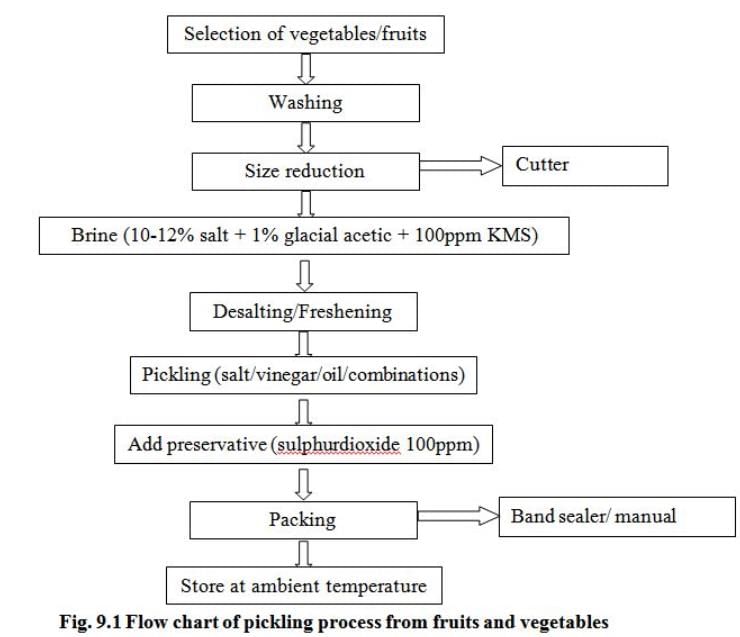
9.2 Processing of Chutneys
Good quality chutney should be palatable and appetizing. Mango chutney is an important food product exported from India to many countries. Apple and apricot chutneys are also very popular in the country. The method of preparation of chutney is similar to that for jam except that spices, vinegar and salt are added. The fruits/vegetables are peeled, sliced or grated, or cut into small pieces and cooked in water until they become sufficiently soft. The quality of chutney depends to a large extent on its cooking which should be done for a long time at a temperature below the boiling point. To ensure proper thickening, cooking is done without a lid even though this results in some loss of volatile oils from the spices. Chopped onion and garlic are added at the start to mellow their strong flavours. Spices are coarsely powdered before adding. Vinegar extract of spices may be used instead of whole spices. Spice and vinegar are added just before the final stage of cooking, because prolonged boiling cause loss of some of the essential oils of spices and of vinegar by volatilization.
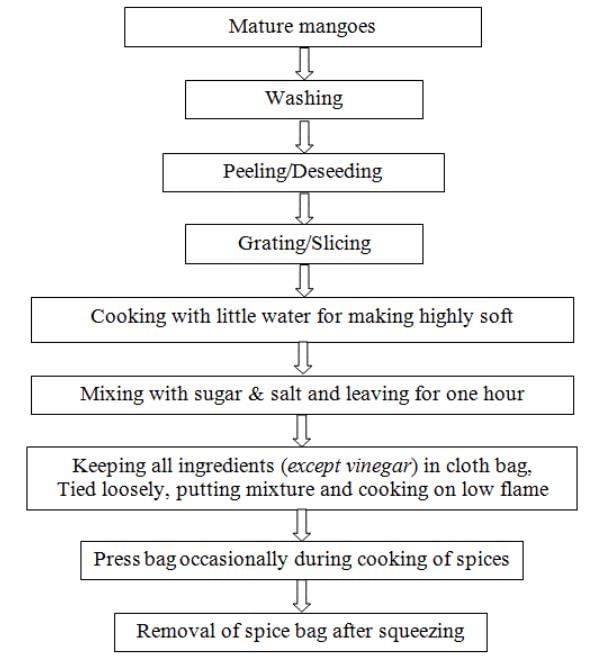
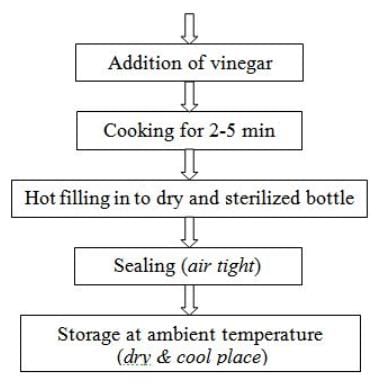
9.3 Processing of Jam
Jam is a product obtained by cooking fruit pulp with sugar and acid to desired consistency. Jam contains 0.5-0.6 per cent acidity and 68 per cent total solids. Apple, pear, tomato, sapota, apricot, loquat, peach, papaya, karonda, carrot, plum, straw berry, raspberry, mango, tomato, grape and muskmelon are used for preparation of jams. It can be prepared from one kind of fruit or two or more kind.
(i) Machines and equipments made of stainless steel can be used for fruits and vegetables processing and preservation
(ii) SS steam jacketed kettle for cooking and concentration
(iii) Fruit Pulpers- Brushes and SS sieves of various sizes are provided which are used for complete extraction from fruits.
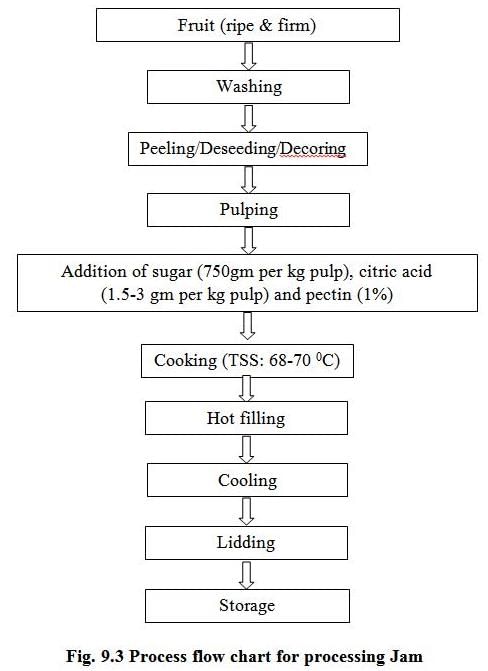
9.4 Processing of Jelly: Jelly is semi solid products obtained by boiling a clear, strained fruit juice with sugar and acid to a thick consistency, jelly total soluble solids not less than 65% and acidity 05-0.7 percent.
9.4.1 Qualities of Jelly
(i) Clear
(ii) Transparent
(iii) Sparkling
(iv) Attractive colour
(v) Keep its shape in which it is cut not breaking.
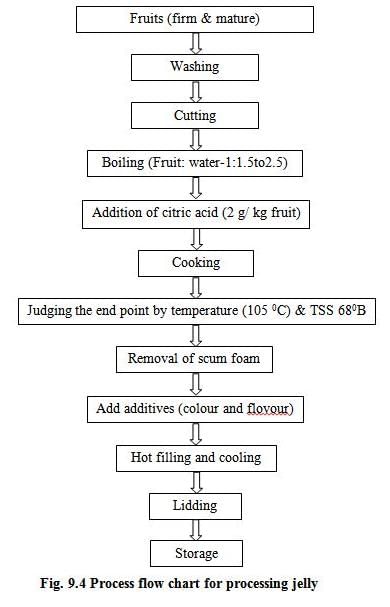
9.5 Processing of Marmalade: Marmalade is a fruit jelly in which peels are suspended. Marmalades are prepared usually from citrus fruits. The protein content of marmalade is slightly higher. FPO specification for marmalade area same as mentioned for jelly.

9.6 Processing of Murabba and Candy: A mature fruit/ vegetable or its pieces impregnated with heavy sugar syrup till it becomes tends and transport is known as preserve or murabba.

9.7 Processing of Squash: A type of fruit beverage which contains at least 25 percent juice and 45 percent total soluble solids is called as squash. It also contains about 1 percent acidity and 350 ppm sulphur dioxide or 600ppm sodium benzoate. It is diluted being served. Squash can be prepared from a wide variety of fruits of viz., mango, mandarin orange, lime, guava, anola, pineapple, papaya, bael, litchi, phalsa, jamun, pomegranate, plum, etc.
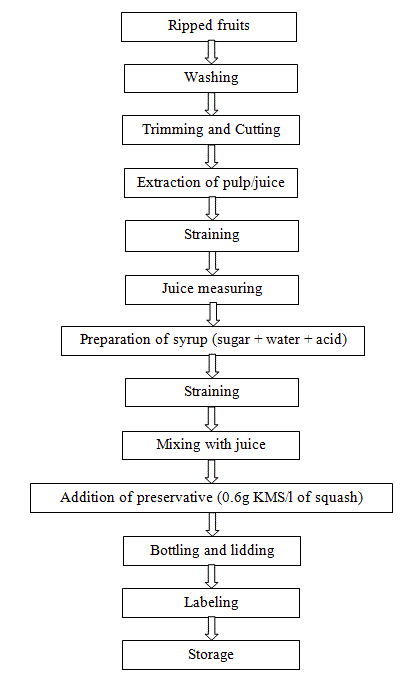
9.8 Processing of Cordial: Cordial is a sparkling clear sweetened fruit juice from which pulp and other suspended materials are completely eliminated. Cordial contains at least 25% fruit juice and 30% total soluble solids with 1.5% per cent acidity. Lime and lemons are most suitable fruits for preparation of cordial. This can also be prepared from other fruits as guava, grape, phalsa, etc.
Specifications
Minimum percentage of total soluble solids 30 and of fruit juice 25. The permissible limits of the preservative as sulphur dioxide or benzoic acid are same as mentioned for squash. The techniques used for preparation of cordial beverages area given under.

9.9 Sauces and Ketchups:
There is no essential difference between sauce and ketchup. However, sauces are generally thinner and contain more total solids (minimum 30%) than ketchups (minimum 28%). Tomato, apple, papaya, walnut, soybean, mushroom, etc., are used for making sauces.
Sauces are of two kinds: (i) Thin sauces of low viscosity consisting mainly of vinegar extract of flavoring materials like herbs and spices, and (ii)Thick sauces that are highly viscous.
Sauces/ketchups are prepared from more or less the same ingredients and in the same manner as chutney, except that the fruit or vegetable pulp or juice used is sieved after cooking to remove the skin, seeds and stalks of fruits, vegetables and spices and to give a smooth consistency to the final product. However, cooking takes longer because fine pulp or juice is used.
Tomato puree and paste: Tomato pulp without skin or seeds, with or without added salt, and containing not less than 9.0 per cent of salt-free tomato solids, is known as 'medium tomato puree'. It can be concentrated further to 'heavy tomato puree' which contains not less than 12 per cent solids. If this is further concentrated so that it contains not less than 25 per cent tomato solids, it is known as tomato paste. On further concentration to33 per cent or more of solids, it is called concentrated tomato paste. Tomato pulp is prepared from ripe tomatoes in the same manner as tomato juice. Cooking for concentration of the pulp can be done either in an open cooker or a vacuum pan. In the former most of the vitamins are destroyed and the product become brown. On the other hand, use of vacuum pans, which are expensive, help to preserve the nutrients and also reduce the browning to a great extent. In vacuum pans the juice is boiled at about 71°C only. Ordinarily tomato juice can be concentrated to 14-15 per cent solids in an open cooker, but for obtaining higher concentrations a vacuum pan is required. Moreover, sterilization of the product is also possible in a vacuum pan. While cooking in an open cooker, a little butter or edible oil is added to prevent foaming, burning and sticking. If, after cooking, the total solids content of the juice is higher. Than required, more juice is added to lower it, if it is lower, cooking is continued till the desired concentration is reached. The end-point of cooking puree and paste can be determined either with a hand refractometer or by measuring the volume (a known volume of juice is concentrated to a known volume of final product) with the help of a measuring stick.
Tomato sauce/ketchup: It is made from strained tomato juice or pulp and spices, salt, sugar and vinegar, with or without onion and garlic, and contains not less than 12 per cent tomato solids and 25 per cent total solids.
9.10 Process of Canning
1. Selection of fruits and vegetables
- Fruits and vegetables should be absolutely fresh.
- Fruits should be ripe, but firm, and uniformly mature. Over-ripe fruits should be rejected because they are infected with microorganisms and give a poor quality product.
- Unripe fruits should be rejected because they generally shrivel and toughen on canning.
- All vegetables except tomatoes should be tender.
- Tomatoes should be firm, fully ripe and of deep red colour.
- Fruits and vegetables should be free from dirt.
- They should be free from blemishes, insect damage or mechanical injury.
2. Grading:
The selected fruits and vegetables are graded according to size and colour to obtain uniform quality. This is done by hand or by machines such as screw grader and roller grader. Fruits like berries, plums and cherries are graded whole, while peaches, pears, apricots, mangoes, pineapples, etc., are generally graded after cutting into pieces or slices.
3. Washing:
It is important to remove pesticide spray residue and dust from fruits and vegetables. One gram of soil contains 1012 spores of microorganisms. Therefore, removal of microorganisms by washing with water is essential. Fruits and vegetables can be washed in different ways. Root crops that loosen in soil are washed by soaking in water containing 25 to 50 ppm chlorine (as detergent). Other methods of washing are spray washing, steam washing, etc.
4. Peeling:
The objective of peeling is to remove the outer layer. Peeling may be done in various ways. (hand peeling, steam peeling, mechanical peeling, lye peeling, flame peeling).
5. Cutting:
Pieces of the size required for canning are cut. Seed, stone and core are removed. Some fruits like plum from which the seeds cannot be taken out easily are canned whole.
6. Blanching:
It is also known as scalding, parboiling or precooking. Fruits are generally not blanched leaving the oxidizing enzyme system active. Sometimes fruit is plunged for a given time-from half to, say, five minutes, according to variety-into water at from 180°F to 200oF, and then immediately cooled by immersion in cold water. The object is to soften the texture and so enable a greater weight to be pressed into the container without damage to the individual fruit. Blanching is usually done in case of vegetables by exposing them to boiling water or steam for 2 to 5 minutes, followed by cooling. The extent of blanching varies with the toed. This brief heat treatment accomplishes the following:
- Inactivates most of the plant enzymes which cause toughness, discolouration (polyphenol oxidase). mustiness, off-flavour (peroxidase), softening and loss of nutritive value.
- Reduces the area of leafy vegetables such as spinach by shrinkage or wilting, making their packing easier.
- Removes tissue gases which reduce sulphides.
- Reduces the number of microorganisms by as much as 99%.
- Enhances the green colour of vegetables such as peas, broccoli and spinach.
- Removes saponin in peas.
- Removes undesirable acids and astringent taste of the peel, and thus improves flavour.
- Removes the skin of vegetables such as beetroot and tomatoes which helps in their peeling.
7. Cooling:
After blanching, the vegetables are dipped in cold water for better handling and keeping them in good condition.
8. Filling:
Before filling, cans are washed with hot water and sterilized but in developing countries these are subjected to a jet of steam to remove dust and foreign material. Automatic, large can-filling machines are used in advanced countries but choice grades of fruits are normally filled by hand to prevent bruising in India. Hand filling is the common practice. After filling, covering with syrup or brine is done and this process is called syruping or brining.
9. Exhausting:
The process of removal of air from cans is known as exhausting. After filling and lidding or clinching, exhausting is essential. The major advantages of exhausting are as under:
- Corrosion of the tinplate and pin holing during storage is avoided.
- Minimizes discolouration by preventing oxidation.
- Helps in better retention of vitamins particularly vitamin C.
- Prevents building of cans when stored in hot climate or at high altitude.
- Reduces chemical reaction between the container and the contents.
- Prevents development of excessive pressure and strain during sterilization.
Containers are exhausted either by heating or mechanically. The heat treatment method is generally used. The cans are passed through a tank of hot water at 82 to 87°C or move on a belt through a covered steam box. In the water exhaust box, the cans are placed in such a manner that the level of water is 4-5 cm below their tops. The exhaust box is heated till the temperature of water reaches 82 to 1000c and the centre of the can shows a temperature of about 79°C. The time of exhausting varies from 6 to 1 a minutes, depending on the nature of the product. In the case of glass jars or bottles, vacuum closing machines are generally used. The bottles or jars are placed in a closed chamber in which a high vacuum is maintained.
It is preferable to exhaust the cans at a lower temperature for a longer period to ensure uniform heating of the contents without softening them into pulp. Exhausting at high temperature should be avoided because. The higher the temperature, the more is the volume of water vapour formed, and consequently the greater the vacuum produced in the can.
10. Sealing:
Immediately after exhausting the cans are sealed airtight by means of a can sealer.
In case of glass jars a rubber ring should be placed between the mouth of the jar and the lid, so that it can be sealed airtight. During sealing the temperature should not fall below 74°C.
11. Processing:
Heating of foods for preserving is known as processing, however, in canning technology processing means heating or cooling of canned foods to inactivate bacteria. Many bacterial spores can be killed by either high or very low temperature. Such drastic treatment, however, affects the quality of food. Processing time and temperature should be adequate to eliminate all bacterial growth. Moreover, over-cooking should be avoided as it spoils the flavour as well as the appearance of the product. Almost all fruits and add vegetables can be processed satisfactorily at a temperature of 100°C, i.e., in boiling water.
The presence of acid retards the growth of bacteria and their spores. Further, they do not thrive in heavy sugar syrup which is normally used for canning of fruits. Vegetables (except the more acid ones like tomato and rhubarb) which are non-acid in nature, have a hard texture, and proximity to soil which may infect them with spore-bearing organisms are processed at higher temperatures of 115 to 1210C.
The sourness of fruits and vegetables is due to their acid content (measured in pH) which has a great influence upon the destruction of microorganisms. The lower the pH the greater is the ease with which a product can be processed or sterilized. Fruits and vegetables can be classified into the following four groups according to their pH value.
Bacterial spores can be more easily destroyed at pH 3.0 (fruits) than at pH 5.0 to 6.0 (vegetables, except tomato and rhubarb). Bacterial spores do not grow or germinate below. pH 4.5. Thus, a canned product having pH less than 4.5 can be processed in boiling water but a product with pH above 4.5 requires processing at 115 at 121oC under a pressure of 0.70 to 1.05 kg/cm2 (10 to 15 lb/sq inch). It is essential that the centre of the can should attain these high temperatures.
The temperature and time of processing vary with the size of the can and the nature of the food: the larger the can, the greater is the processing time. The processing time 'for different canned fruits and vegetables is given in the tables Under 'Canning of Fruits' and 'Canning of Vegetables'. Fruits and acid vegetables are generally processed in open type cookers, continuous non-agitating cookers and continuous agitating cookers, while vegetables (non-acid) are processed under steam pressure in closed retorts known as automatic pressure cookers. In India, small vertical stationary retorts (frontispiece) are generally used for canned vegetable processing. The sealed cans are placed in the cookers, keeping the level of water 2.5 to 5.0 cm above the top of the cans. The cover of the cooker is then screwed down tightly and the cooker heated to the desired temperature. The period of sterilization (processing) should be counted from the time the water starts boiling. After heating for the required period the cooker is removed from the fire and the petcock is opened. When the pressure comes down to zero the cover is removed and the cans are taken out.
12. Cooling: After processing. the cans are cooled rapidly to about 39°C to stop the cooking process and to prevent stack-burning. Cooling is done by the following methods:
- dipping or immersing the hot cans in tanks containing cold water;
- letting cold water into the pressure cooker specially in case of vegetables;
- Spraying cans with jets of cold water; and
- exposing the cans to air.
Generally the first method, i.e., dipping the cans in cold water, is used. If canned products are not cooled immediately after processing, peaches and pears become dark in colour, tomatoes turn brownish and bitter in taste, peas become pulpy with cooked taste and many vegetables develop flat sour (become sour).
13. Storage:
After labeling the cans, they should be packed in strong wooden cases or corrugated cardboard cartons and stored in a cool and dry place. The outer surface of the cans should be dry as even small traces of moisture sometimes induce rusting. Storage of cans at high temperature should be avoided, as it shortens the shelf-life of the product and often leads to the formation of hydrogen swell. The marketable life of canned products varies according -to the type of raw materials used. Canned peach, grapefruit, pineapple, beans, spinach, pea etc., can be stored for about two years, while pear, apricot, carrot, beetroot, tomato, etc., can be stored for a comparatively short period only.
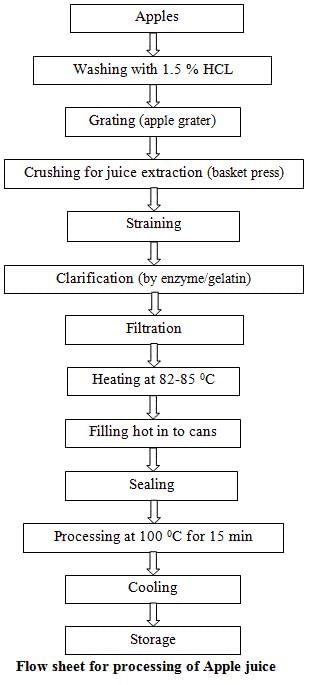
9.11 Major challenges, constraints and concerns
- Despite policy initiatives, growth potential and significant achievements, there are several disturbing trends as delineated here:
- In India, the value addition to food fortification is only 7% compared to as much as 23% in China, 45% in Philippines and 188% in the UK. The small-scale and unorganised sectors account for 75% of the total industry.
- The basic problem associated with the industry is the sustained availability of suitable raw material for processing. Moreover, the productivity is also very low as compared to many other countries. The cost of raw material used for processing is 3 to 4 times more as compared to costs in the world market.
- External liberalisation poses threats of stiffer competition under a new world trade order with WTO agreements relaxing quantitative restrictions and non-tariff/sanitary barriers on importing countries which exposes the Indian farmer to world market forces. Under the new trade regime, the food sector will be confronted by challenges of trade related Intellectual Property Rights, comprising patent laws, copyrights, trade links, etc.
- The inherent strength of high raw material production and large domestic market base has to be buttressed with operating processing units at optimum capacity levels as per economies of scale which would enable achieving a competitive edge over imported products.
- With the increasing competition from the international trade, quality of imported products will become more available in the developing countries. Therefore, to compete, the developing countries require proper post harvest management, distribution and processing chains. Hence, it is necessary to have better human resource capabilities in technology, management and marketing.
- Advances in bio-technology have enabled production of Genetically Modified (GM) foods. These have already appeared in some countries. GM foods need be critically examined on their good and adverse impacts on human health.
- Taxes on processed food in India are among the highest in the world. No other country imposes excise duty on processed food and distinguishes between branded and unbranded food sectors for taxation. There is excise duty of 16% in the form of CENVAT levied on food products. Besides there is sales tax, octroi, mandi samiti, entry tax and customs duty on material, levied by the Central/State/Local bodies. The net effect ranges from 21% to 30% on various food items.
- Policies like participation of private sectors through contract farming and land leasing arrangement can assure supply of good quality raw material to the fruit and vegetable processing industry.
- It is very vital to educate consumer about the processed fruit and vegetable based products and their nutritional quality.
- Backward-forward integration from farm to processors and consumers and also to generate more employment to eliminate poverty.
- Should have control over taxation with other nations during export and import of the processed fruit and vegetable products.
- Commercial R&D activities in the food industry have remained confined to only a few areas. R&D activities have scarcely emerged from the laboratory to be extensively adopted on the field.
- Indian brands have yet to acquire an image in the international markets because of poor global marketing.
- Most Financial Institutions lack capacity to appraise hi-tech export-oriented projects. There are no suitable insurance schemes for such projects, most of which deal in export of perishables. In financing such projects the banks face considerable credit risks. With new technology, the risk perception is higher than the existing one.
The sector has been characterized by poor marketing, transport and communication infrastructure. The market density of fruits and vegetables is low and facilities for storage and cold chains in the hinterlands are woefully inadequate. Erratic and inadequate power supply, lack of roads, lack of quality water, education and health facilities and null or low rural industrialization accentuates the problems.

|
Explore Courses for Agricultural Engineering exam
|

|

















